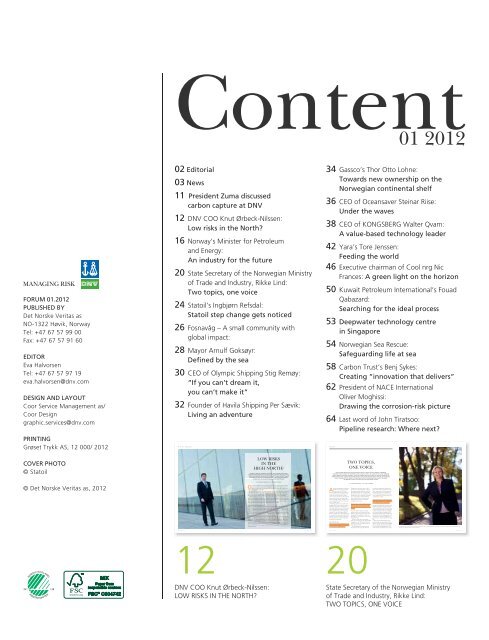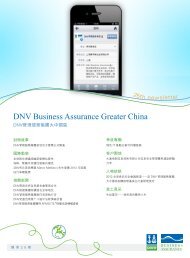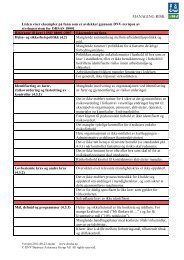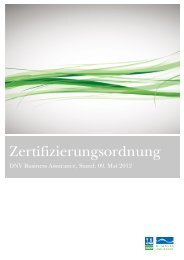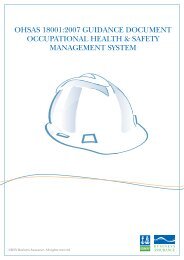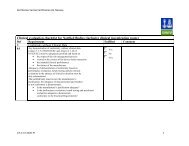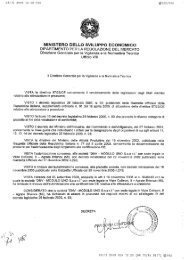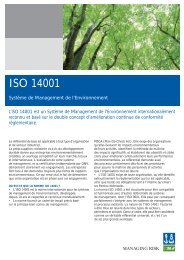Download - DNV Business Assurance
Download - DNV Business Assurance
Download - DNV Business Assurance
Create successful ePaper yourself
Turn your PDF publications into a flip-book with our unique Google optimized e-Paper software.
12 – no 01 2012<br />
MAJOR OIL AND GAS ACCIDENTS IN THE PAST FEW DECADES HAVE FORCED<br />
SIGNIFICANT IMPROVEMENTS IN TECHNOLOGY, PROCEDURES AND REGULATIONS.<br />
“NOW, WHEN SEEKING OPPORTUNITIES IN THE ARCTIC AREAS WE MUST ENSURE<br />
THE SAME LEVEL OF RISK AS IN THE NORTH SEA,” EMPHASISES KNUT ØRBECK-<br />
NILSSEN, <strong>DNV</strong> COO DIVISION NORWAY, RUSSIA AND FINLAND.<br />
TEXT: SVEIN INGE LEIRGULEN PHOTOS: DAMIR CVETOJEVIC<br />
il and gas producing countries have experienced several catastrophic accidents<br />
in the past 30 years. Alexander L. Kielland in Norway, Piper Alpha in the UK,<br />
Montara in Australia and Deepwater Horizon in the US have all claimed many<br />
lives or caused significant oil spills.<br />
Mr Ørbeck-Nilssen explains that another common characteristic with all these tragedies<br />
is that they were completely unexpected. However, they have forced the development of<br />
improved procedures, standards and technologies. On the regulatory side, responsibilities<br />
have become clearer and new governmental safety agencies have been established.<br />
“Offshore safety has never been so high on the public agenda as in the past year. The<br />
industry is debating how to improve technologies and safety solutions, and authorities in<br />
both the US and the EU are developing stricter requirements for oil and gas operations.<br />
There is no doubt that the rules of the game will change with more focus on offshore<br />
safety, environmental protection and risk assessments,” he predicts.<br />
RISK MANAGEMENT ENHANCES SAFETY<br />
“The use of a risk management approach is vital to increase safety. We should not confuse<br />
the risk of a certain event taking place with only the consequences it may result in.<br />
That is not taking into account the likelihood for the event to occur. This approach, the<br />
so-called ‘worst case scenario’ will lead to many decisions without a sound factual basis.<br />
“This is not what risk is about. Risk management is about increasing safety by analyzing<br />
what and where something can go wrong, minimising the probability for it to occur and<br />
ensuring that you can reduce its consequences,” he clarifies.<br />
An oil and gas operator who embraces this approach within its management system will<br />
be able to enhance and manage safety levels, continuously. Authorities that base their<br />
regulations on a risk based approach will also have a pragmatic tool that enables them<br />
to decide on an acceptable level of risk for their countries to harvest resources. This also<br />
provides the basis for regulations that allow for technology development and new and<br />
better solutions. Risk analyses will further provide a common interface for discussions<br />
between stakeholders, for example regarding a decision of whether or not to allow an<br />
industrial activity.<br />
no 01 2012 – 13<br />
<strong>DNV</strong> HAS BEEN INVOLVED IN THE LNG INDUSTRY SINCE THE 1960S, AND THE COMPANY IS WORKING<br />
ON PROJECTS RIGHT ACROSS THE SPECTRUM OF LNG ACTIVITIES. TODAY, LNG IS ONE OF THE FASTEST GROWING<br />
ENERGY MARKETS AROUND THE WORLD. GIVEN THE NUMBER AND SCALE OF NEW LNG PROJECTS PROPOSED OR<br />
UNDER CONSTRUCTION, GLOBAL PRODUCTION CAPACITY COULD MORE THAN DOUBLE BY THE END OF THE DECADE.<br />
<strong>DNV</strong> IS WORKING HARD TO SHARE ITS COMPETENCIES WITH CUSTOMERS AND THE INDUSTRY, ENSURING<br />
LNG REMAINS A VIABLE, COST-EFFECTIVE AND SAFE ENERGY SOURCE.<br />
nother expanding area of business Compared to other fuel sources, LNG is to help with studying the distribution of<br />
for <strong>DNV</strong> concerns the growth of good for the environment and – with the LNG, and we share our experience with<br />
the Arctic region. The United developments being made here – good for other countries in the Nordic region. We<br />
States Geological Survey believes that the Norwegian business. For example, <strong>DNV</strong> have also met with the EU commission<br />
Arctic seabed contains nearly 20% of the has come with many new concepts for LNGfuelled<br />
ships, such as Triality, a concept for on our experiences and advise on how to<br />
and with the Russian government to pass<br />
world’s oil reserves and 30% of its gas<br />
reserves. Add to that the fact that ships will new, energy-efficient tankers. <strong>DNV</strong> has extend the use of LNG.<br />
soon be able to sail across an open Arctic taken a lead in this area, and research<br />
Ocean during the summer months, and it programs such as these are on-going<br />
What is being done to raise the knowledge necessary<br />
to develop infrastructure for distribution<br />
is no wonder <strong>DNV</strong> expertise in Arctic matters<br />
is so sought after.<br />
and refuelling terminals on a global basis?<br />
throughout the country.<br />
With these two issues very much in the Norway already has a leading position in the use<br />
spotlight, <strong>DNV</strong> Forum decided to take the of LNG as a fuel, such as on ferries and supply Norway has, alongside other countries and<br />
opportunity to speak to a key player on ships. What explains Norway’s pioneering role in maritime operators in Northern Europe,<br />
these topics. Rikke Lind, a Norwegian politician,<br />
was appointed in 2005 to the posi-<br />
at the distribution of LNG as a marine fuel<br />
this area?<br />
financed a feasibility study that is looking<br />
tion of State Secretary of the Norwegian We have a long heritage as a maritime in ports around the North Sea and Baltic<br />
Ministry of Trade and Industry. Due to nation, and over recent decades we have Sea. Once this study is complete it will<br />
Norway’s prominence in the shipping industry,<br />
ownership of oil and gas resources and Combining the capabilities of these two therefore the decision-making process, for<br />
built our competence in the energy sector. undoubtedly improve the knowledge, and<br />
location close to Arctic waters, Ms Lind is disciplines, it is no wonder we are now taking<br />
a global lead.<br />
panies that are considering LNG as a ship<br />
the authorities, ports and shipping com-<br />
often involved in these issues both domestically<br />
and internationally.<br />
The three main efforts that explain fuel.<br />
Norway’s pioneering role in environmental Much of this understanding is being<br />
THE FUTURE OF LNG<br />
shipping are: The NOx Fund; LNG a fuel gained through the pioneering work in a<br />
Norway has taken the lead developing the “LNG on ferries; and the use of LNG as fuel on number of ports, and the report highlights<br />
as fuel” concept for shipping. What development some offshore vessels.<br />
these as examples that others can benefit<br />
do you see here in a global perspective?<br />
The Norwegian government also has from. A project being undertaken at the<br />
an important role to play. We did work LNG terminal in Gothenburg is an exam-<br />
20 – no 01 2012<br />
TEXT: RICHIE MACTAGGART PHOTOS: NINA E. RANGØY<br />
I “Compared to other fuel sources, LNG is good for the environment and – with the developments being made here – good for Norwegian business,” says Rikke Lind, State<br />
Secretary of the Norwegian Ministry of Trade and Industry.<br />
no 01 2012 – 21<br />
Content<br />
01 2012<br />
FORUM 01.2012<br />
PUBLISHED BY<br />
Det Norske Veritas as<br />
NO-1322 Høvik, Norway<br />
Tel: +47 67 57 99 00<br />
Fax: +47 67 57 91 60<br />
EDITOR<br />
Eva Halvorsen<br />
Tel: +47 67 57 97 19<br />
eva.halvorsen@dnv.com<br />
DESIGN AND LAYOUT<br />
Coor Service Management as/<br />
Coor Design<br />
graphic.services@dnv.com<br />
PRINTING<br />
Grøset Trykk AS, 12 000/ 2012<br />
COVER PHOTO<br />
© Statoil<br />
02 Editorial<br />
03 News<br />
11 President Zuma discussed<br />
carbon capture at <strong>DNV</strong><br />
12 <strong>DNV</strong> COO Knut Ørbeck-Nilssen:<br />
Low risks in the North?<br />
16 Norway’s Minister for Petroleum<br />
and Energy:<br />
An industry for the future<br />
20 State Secretary of the Norwegian Ministry<br />
of Trade and Industry, Rikke Lind:<br />
Two topics, one voice<br />
24 Statoil’s Ingbjørn Refsdal:<br />
Statoil step change gets noticed<br />
26 Fosnavåg – A small community with<br />
global impact:<br />
28 Mayor Arnulf Goksøyr:<br />
Defined by the sea<br />
30 CEO of Olympic Shipping Stig Remøy:<br />
“If you can’t dream it,<br />
you can’t make it”<br />
32 Founder of Havila Shipping Per Sævik:<br />
Living an adventure<br />
+ Arctic operation<br />
LOW RISKS<br />
IN THE<br />
HIGH NORTH?<br />
34 Gassco’s Thor Otto Lohne:<br />
Towards new ownership on the<br />
Norwegian continental shelf<br />
36 CEO of Oceansaver Steinar Riise:<br />
Under the waves<br />
38 CEO of KONGSBERG Walter Qvam:<br />
A value-based technology leader<br />
42 Yara’s Tore Jenssen:<br />
Feeding the world<br />
46 Executive chairman of Cool nrg Nic<br />
Frances: A green light on the horizon<br />
50 Kuwait Petroleum International’s Fouad<br />
Qabazard:<br />
Searching for the ideal process<br />
53 Deepwater technology centre<br />
in Singapore<br />
54 Norwegian Sea Rescue:<br />
Safeguarding life at sea<br />
58 Carbon Trust’s Benj Sykes:<br />
Creating “innovation that delivers”<br />
62 President of NACE International<br />
Oliver Moghissi:<br />
Drawing the corrosion-risk picture<br />
64 Last word of John Tiratsoo:<br />
Pipeline research: Where next?<br />
+ LNG<br />
TWO TOPICS,<br />
ONE VOICE<br />
© Det Norske Veritas as, 2012<br />
O<br />
A<br />
12<br />
20<br />
<br />
<br />
<br />
<br />
<strong>DNV</strong> COO Knut Ørbeck-Nilssen:<br />
LOW RISKS IN THE NORTH?<br />
State Secretary of the Norwegian Ministry<br />
of Trade and Industry, Rikke Lind:<br />
TWO TOPICS, ONE VOICE


